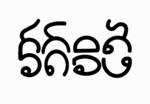Rhavanese language
| Khotirava | |
|---|---|
| Rhavanese | |
| Ghātikhaobák | |
 | |
| Pronunciation | [ɣatikaːwbɑːk] (Ghatikhaobak) [kɔtirəwɑː] (Khotirava) |
| Native to | Rhava |
| Ethnicity | Rhavanese |
Native speakers | 21,348,102 (2021) Total speakers: 26,954,034 |
Austroasiatic
| |
Early forms | |
| Dialects | |
| Rha script Rha Braille | |
| Official status | |
Official language in | Template:RHA |
| Regulated by | Rhavanese Culture Preservation Agency |
| Language codes | |
| ISO 639-1 | rhav |
| ISO 639-2 | rhav |
| ISO 639-3 | rhav – inclusive codeIndividual codes: kha – Khamkhn – Khnembak – Baknam – Nam |
| [[File:]|220px]] | |
Rha, or Khótirâvá alternatively referred to as Ghātikhaobák, is an Alharun native language of the Indonadisi family spoken by Rhavanese people in a number of dialects. It is one of a couple official languages in Rhava.
Usage
Rha and its dialects are the native languages of all provinces excluding the Nalinese Autonomous Region, and the provinces of Nokornhai, Amoujawat, and Khiewmawthu. The Rhavanese diaspora overseas also uses Rha for signs, and restaurants. Rha study is mandatory in all schools, and the language is the lingua franca in the provinces to the south and east, where it is not the mother tongue.
Writing System
Rha after Salvian colonization was written in the latin script, with different marks indicated how to pronounce vowels and some consonants. The Rha script however is still used in decorative, historical, and ceremonial use. The Rha script is an abugida system.